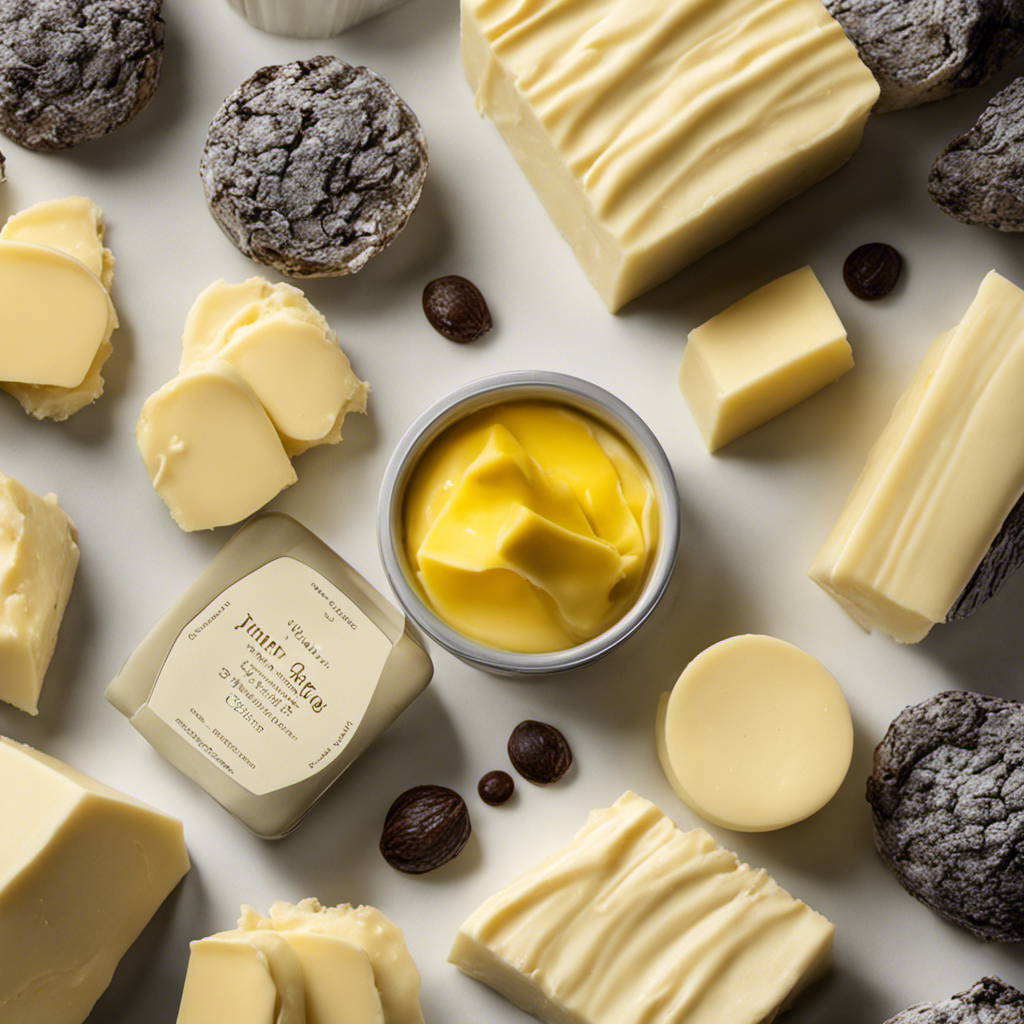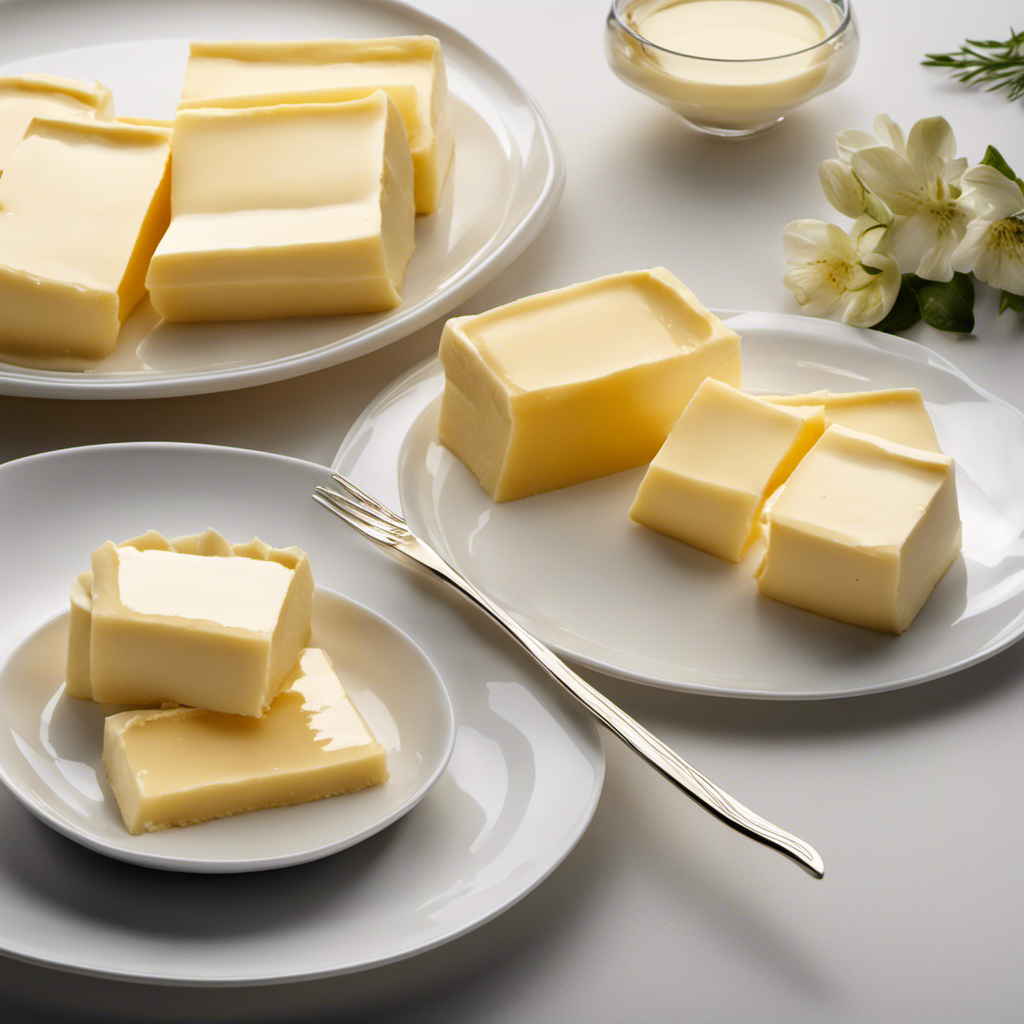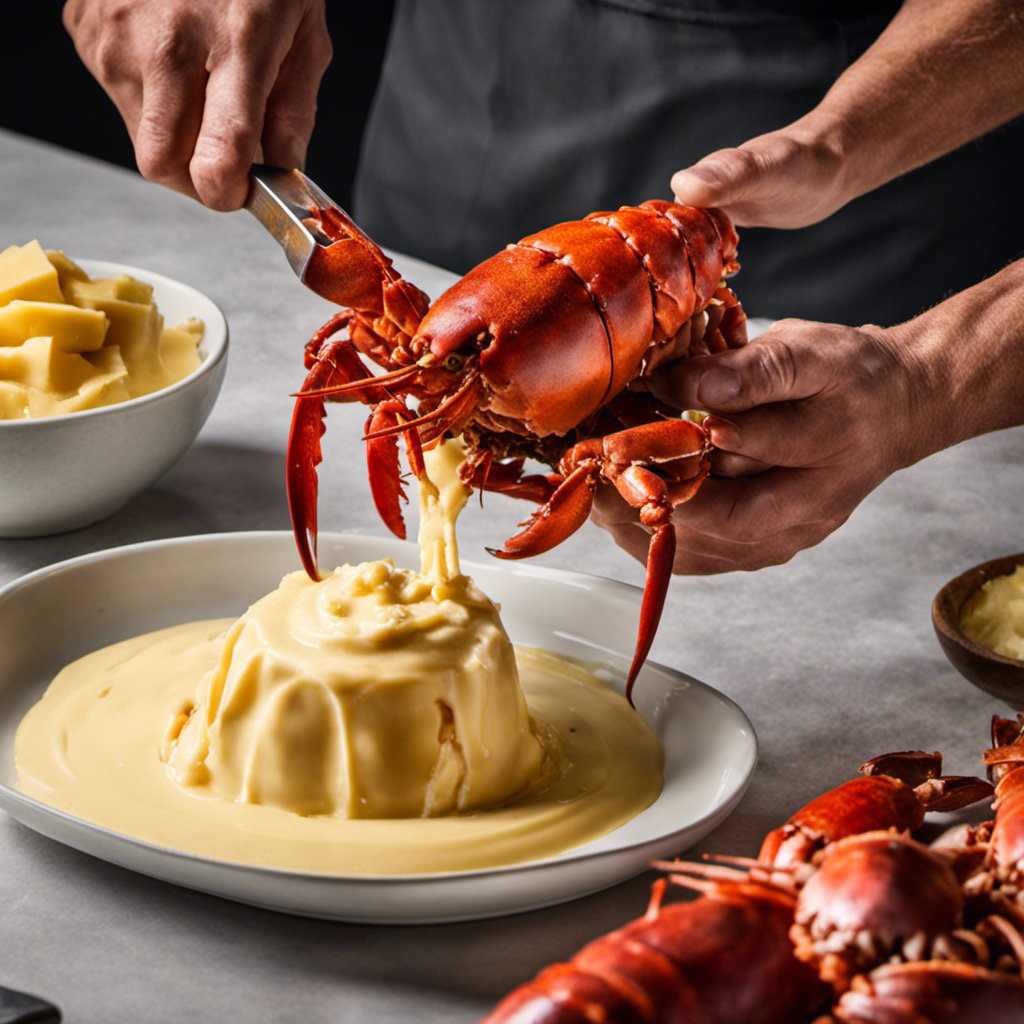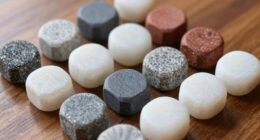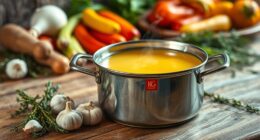Similar to a detective analyzing a crime scene, I constantly examine the butter in my refrigerator, looking for any indication of spoilage. Butter, known for its creamy consistency and flavorful taste, is a essential ingredient in my kitchen.
But how can I be sure if it’s gone bad? In this article, I will guide you through the clues to look for when determining if your butter is past its prime. From changes in color and texture to off odors and mold growth, we’ll explore the science behind identifying spoiled butter.
Key Takeaways
- Signs of spoiled butter include strange colors (grey, brown, green, or blue spots) and unusual textures (grainy, oily, or slimy).
- The presence of an off smell or unusual taste is an indication that butter is spoiled.
- Proper storage in the refrigerator can extend the shelf life of butter.
- Mold growth can occur in butter, so it’s important to store it in cool and dry conditions and regularly check for mold.
Color and Texture Changes
If your butter has developed a strange color or an unusual texture, it may be a sign that it is bad. Color changes in butter can occur due to oxidation or exposure to light. Normally, butter should have a pale yellow color, but if it starts to turn grey, brown, or develops green or blue spots, it is likely spoiled.
Texture changes in butter can also indicate spoilage. Fresh butter should be smooth and creamy, but if it becomes grainy, oily, or develops a slimy texture, it is no longer good to use. These changes in color and texture are usually caused by the breakdown of fats and proteins in the butter, leading to an unpleasant taste and potential health risks.
Off or Rancid Odor
When it comes to detecting spoiled butter, one of the key indicators is a foul smell. A rancid odor is often a sign that the butter has gone bad and should not be consumed.
In addition to the unpleasant smell, other signs of bad butter may include a change in texture, such as becoming greasy or grainy, and a noticeable change in taste.
Foul Smell Indicates Spoilage
To determine if your butter has gone bad, simply take a whiff – if it smells foul, it’s spoiled.
Butter quality is an important factor in ensuring a delightful culinary experience. Freshness indicators play a crucial role in determining the quality of butter.
One such indicator is the smell. When butter is fresh, it has a pleasant, creamy aroma. However, as it ages and begins to spoil, the smell becomes rancid or foul. This is due to the breakdown of fats in the butter, which produces undesirable odors. These odors can range from sour to putrid, indicating that the butter is no longer suitable for consumption.
Therefore, always trust your nose when it comes to assessing the freshness of your butter.
Detecting Rancid Butter
To determine whether your butter has spoiled, simply rely on your sense of smell – a foul odor is a clear indicator of rancidity. Butter quality is determined by its freshness and taste. When butter goes bad, it develops a strong, unpleasant smell due to the breakdown of its fats. This odor is often described as sour or cheesy.
The shelf life of butter varies depending on factors such as storage conditions and the presence of preservatives. Typically, butter can be safely consumed within a few weeks of purchase. However, if you notice a foul smell or any other signs of spoilage, it is best to discard the butter to avoid any potential health risks.
Regularly checking the smell of your butter can help ensure its quality and avoid consuming rancid butter.
Signs of Bad Butter
If you notice an off smell or an unusual taste, it’s likely that the butter has spoiled. Butter, like any other food, has a limited shelf life. It can go bad due to various factors, such as exposure to air, light, or heat.
The shelf life of butter can be extended by keeping it in the refrigerator. However, if it has been stored for too long, it may still spoil. When butter spoils, it becomes rancid, developing a sour or bitter taste and a strong, unpleasant odor.
If you find that your butter has gone bad, it’s important to discard it to avoid any potential health risks. If you prefer butter alternatives, there are various options available, such as margarine, ghee, or plant-based spreads. These alternatives can be a healthier choice for those who are lactose intolerant or following a vegan diet.
Mold Growth
Mold growth can cause butter to develop an unpleasant odor and appearance. It is important to prevent the growth of mold in order to extend the shelf life of butter.
Mold can thrive in warm and humid environments, so it is crucial to store butter in cool and dry conditions. Additionally, keeping butter away from other foods that may already be contaminated with mold can help prevent its growth.
Proper packaging is also essential in mold prevention. Using airtight containers or wrapping butter tightly in aluminum foil can help keep out moisture and prevent mold from forming.
Regularly checking the butter for any signs of mold and promptly discarding any affected portions can further extend its shelf life and ensure its safety for consumption.
Expiration Date
The expiration date on butter packaging indicates the recommended time for consumption. It is important to pay attention to this date to ensure that the butter is still safe to eat.
Proper storage is also crucial in extending the shelf life of butter. Butter should be kept in the refrigerator at a temperature below 40°F (4°C) to prevent spoilage. It is best to store butter in an airtight container or its original packaging to protect it from odors and moisture.
When stored properly, butter can typically last for several weeks beyond its expiration date. However, it is always important to use your senses to determine if butter has gone bad.
In the next section, we will discuss how to perform a taste test to assess the quality of butter.
Taste Test
When it comes to determining if butter is no longer good to consume, there are several key indicators to look for.
One of the first things to consider is the taste – does it have a sour or rancid flavor?
Additionally, texture changes can also be a sign of spoilage, such as the butter becoming grainy or oily.
Lastly, an off-putting odor can be a clear indication that the butter has gone bad.
Sour or Rancid
If your butter smells funky or tastes off, it’s time to toss it out. Detecting spoiled butter is important to avoid any potential health risks that come with consuming bad butter. Spoiled butter can contain harmful bacteria or molds that can lead to foodborne illnesses. To help you determine if your butter has gone bad, here are some signs to look out for:
| Signs of Spoiled Butter | What it Means |
|---|---|
| Sour or rancid smell | Indicates the presence of bacteria or molds. |
| Mold growth | Indicates that the butter has been contaminated. |
| Unusual texture or color | Can be a sign of spoilage or oxidation. |
These signs should not be ignored, as consuming bad butter can cause gastrointestinal issues and other health problems. Now, let’s explore the next topic: texture changes.
Texture Changes
One way to determine if your butter has spoiled is by checking for any unusual changes in texture. Detecting spoilage in butter is important to ensure that it is safe for consumption. Butter has a relatively long shelf life, but it can go bad if not stored properly or if it is past its expiration date.
When butter spoils, its texture can change significantly. It may become soft, greasy, or even slimy. Additionally, it may develop a yellow or brown discoloration, indicating the presence of mold or bacteria. These changes in texture are clear signs that the butter has spoiled and should not be consumed.
It is always recommended to check the expiration date and store butter in a cool, dry place to maximize its shelf life.
Off-Putting Odor?
Detecting spoilage in butter is crucial, especially when it has an off-putting odor. As a consumer, it’s important to know when butter has gone bad to avoid any unpleasant experiences. Here are some key indicators to look out for:
-
Offensive Smell: If your butter emits a rancid or sour smell, it is likely spoiled and should not be consumed.
-
Change in Texture: Spoiled butter may become greasy or develop a grainy texture, indicating that it is no longer fresh.
-
Mold Growth: If you notice any mold or unusual discoloration on the surface of your butter, it is a clear sign of spoilage.
Proper butter storage is essential for maximizing its shelf life. To ensure freshness, store butter in an airtight container in the refrigerator, away from other strong-smelling foods. It is also important to check the expiration date and use the butter within that timeframe for the best quality.
Freezer Burn
To determine if your butter has freezer burn, check for any discolored or dry patches on the surface. Freezer burn occurs when moisture in the butter evaporates, leaving behind dry areas. It can affect the taste and texture of the butter, making it less desirable to use in cooking or baking. Freezer burn does not necessarily mean that the butter is expired, but it does indicate that it has been stored improperly. It is important to check the expiration date on the packaging to ensure that the butter is still safe to consume. Here is a table summarizing the signs of freezer burn and the recommended actions to take:
| Sign of Freezer Burn | Recommended Action |
|---|---|
| Discolored patches | Cut off the affected areas before using |
| Dry patches | Use as soon as possible, but note that the texture may be affected |
| Off-putting odor | Discard the butter as it is likely spoiled |
Packaging and Storage
Check the packaging for any instructions on how to properly store the butter to avoid freezer burn. Proper storage is crucial to maintain the quality and extend the shelf life of butter. Here are three key points to consider:
-
Keep the butter tightly sealed in its original packaging or transfer it to an airtight container to prevent exposure to air and moisture.
-
Store the butter in the coldest part of the refrigerator, preferably at a temperature between 32-41°F (0-5°C). This helps to slow down the oxidation process and keep the butter fresh for longer.
-
Avoid storing butter in the refrigerator door as it is often exposed to temperature fluctuations. Instead, place it on a shelf towards the back of the refrigerator where the temperature is more consistent.
Frequently Asked Questions
Can I Still Use Butter if It Has a Slight Change in Color and Texture?
If butter has a slight change in color and texture, it may be a sign of spoilage. To determine if it’s still safe to use, consider butter storage tips and look for other signs of spoiled butter.
What Should I Do if My Butter Smells off or Rancid?
If my butter smells off or rancid, I immediately discard it. Rancid butter is not safe for consumption. However, there are alternative uses for rancid butter such as making homemade soap. To avoid spoilage, store butter in an airtight container in the refrigerator.
How Can I Prevent Mold Growth on My Butter?
To prevent butter spoilage and ensure its freshness, it’s important to follow best storage practices. This includes keeping it in an airtight container, refrigerating it at the right temperature, and using it within its expiration date.
Is It Safe to Consume Butter Past Its Expiration Date?
It is not safe to consume butter past its expiration date due to food safety concerns. However, expired butter can be used for alternative purposes such as baking or as a moisturizer for dry skin.
Can I Rely Solely on a Taste Test to Determine if My Butter Is Bad?
I can’t rely solely on a taste test to determine if my butter is bad. While taste can be an indicator, other methods like checking for mold or rancid smell are more reliable.
Conclusion
In conclusion, identifying when butter has gone bad is crucial for maintaining food safety. By paying attention to changes in color and texture, detecting an off or rancid odor, and noticing any mold growth, one can quickly determine if the butter has spoiled.
Additionally, checking the expiration date and conducting a taste test can be helpful indicators. Just like a seasoned detective unraveling clues, being vigilant about packaging and storage, as well as noticing freezer burn, will ensure that your butter remains fresh and flavorful.
